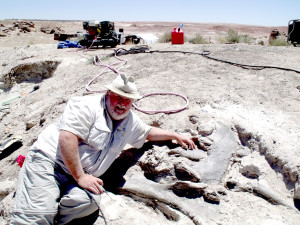By Susan Bromley
Staff Writer
Brandon Twp.- Joe Kchodl digs dinosaurs.
Literally.

The paleontologist, who goes by the name of PaleoJoe, will share stories of his unearthing of various dinosaurs, as well as provide education about the lives and deaths of prehistoric creatures during the program, “Dinosaur CSI” set for 4-5 p.m., June 3, at the library, 304 South St. The free presentation is for all ages.
Kchodl said he has been unearthing dinosaurs for 15 years, but has had a fascination with digging in the dirt since he was a kid. He uncovers fossils regularly in Michigan, leading five digs per year in the Alpena area, which he said is fossil-rich. He does not dig for mammoths or mastodons, which he said are usually found by accident and for which paleontologists from Cranbrook and the University of Michigan are usually called in.
Kchodl does freelance work with the Burpee Museum in Rockford, Ill. And as such, goes on digs out west. This year, he has a trip planned for Wyoming in August, but for the past eight years, he has dug in Utah. Five years ago, he found a camarasaurus there in the desert.
“I went to the top of a hill and took a push broom and pushed away the sand and uncovered a small piece of bone and I got a paint brush just like ‘Jurassic Park’ and brushed away the sand and uncovered a bone about 5 feet long and kept finding more and more bones until I found the hip structure of a dinosaur,” recalls Kchodl, who said paleontologists have a general idea of where they will have success in finding bones.
“I moved 5 feet away and found the shoulder blades and the front legs of a dinosaur. The problem is we never find a complete one.”
In the case of the camarasaurus, a 60-foot long herbivore that lived between 145 and 155 million years ago, the neck, tail, and toes were missing.
Paleontologists can spend years uncovering dinosaurs, and Kchodl was still working on digging at the camarasaurus site last year when he found an apatosaurus, a sauropod that lived in the Jurassic period and reached an average length of 69-75 feet. He discovered the scapula of the dinosaur and lab research revealed the dinosaur had been about 9-years-old when he died.
“The bones are like rings on a tree,” said Kchodl, describing how the age is determined. “The bones also show bite marks, scratches, breaks.”
“I clear away dirt and hit those bones and it’s a great thrill,” he continued. “No matter what I am looking for and find, it’s like Christmas everyday… It’s important to learn about our past, what the Earth was like millions of years ago, how the dinosaurs lived and died, and our ancient history.”
For more information or to register for “Dinosaur CSI,” call 248-627-1461 or visit
www.brandonlibrary.org.
